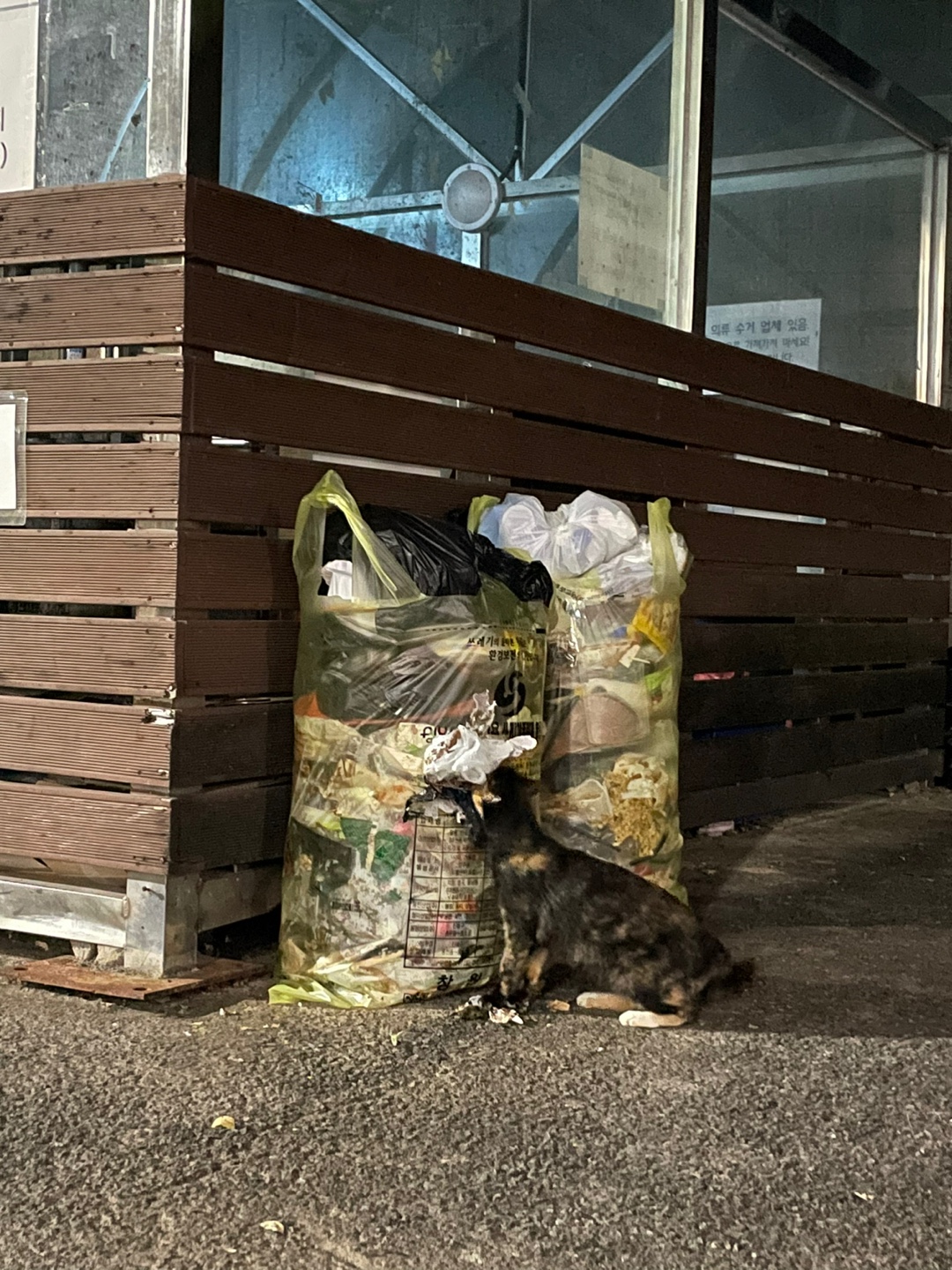 |
| ▲ The cat tearing open a trash bag in the dumpster in front of the dormitory |
On August 28, Cheonan City became the first city in the country to announce the enactment of the ‘Stray Cat Protection and Management Ordinance.’ After the announcement of the legislation, the Cheonan City Council bulletin board showed conflicting opinions for and against the ordinance. Afterward, at the second meeting of the Economy and Industry Committee on September 13, the ordinance was put on hold in the name of social consensus. Stray cats are commonly known as animals loved by people for their unique, cute appearance. However, as the cat population increases, the number of noise complaints regarding being bothered by cats crying every night increases, and the number of trash bags torn open by cats also increases, creating an unsanitary situation. As a result, people are becoming more and more unfavorable towards cats.
The public cat protection and distribution center called ‘Cat School’ in Tongyeong City can be cited as a positive example regarding stray cats. The ‘Cat School,’ which opened in Yongho Island on September 6, remodeled a school that was closed due to a decrease in the number of students, and recreated it as a new space. The majority of existing animal protection centers were operated with a focus on dogs, and when a stray cat is admitted, it goes through the following stages: Trap- Neuter- Return. However, Tongyeong’s ‘Cat School’ is different, in that it supports protection and distribution only for cats. The ‘Cat School’ is equipped with a playground, protection room, treatment room, cat book cafe, and a senior cat room. Currently, 30 cats have been rescued from Hallyeo Haesang National Marine Park and are being protected, and up to 120 cats can be protected at capacity. The ‘Cat School’ is a project that was selected in the 2020 Gyeongnam Province Resident Participatory Budgeting Contest and began in earnest. ‘Utilization of a closed school,’ ‘Yonghodo Island’s historicity,’ ‘possibility of coexistence of humans and animals,’ and, ‘revitalization of an underdeveloped island,’ etc., combined with the element of stray cats created a successful synergy, making it a meaningful example of humans and cats can live in unity through this project.
On the other hand, Australia has declared war on stray cats. Australian Environment Minister Tania Plibersek said stray cats attack thousands of native animals - (6 million every night, or more than 2 billion every year)- and claim the lives of endangered reptiles, birds, and mammals. Even the UN advisory body IPBES assessed that stray cats are one of the animals that have a negative impact on biodiversity and the ecosystem in Australia. According to Australia's Department of Environment, it is estimated that between 1.4 and 5.6 million stray cats live in Australia and that about two- thirds of the mammals that have become extinct in Australia over the past 200 years must have been related to stray cats. The Ministry of Environment's draft plan to eradicate stray cats includes methods such as controlling the stray cat population through spay and neutering surgeries and spraying toxic gel using machines. In addition, the Ministry of Environment plans to solicit opinions through public consultation until December to prevent the spread of stray cats.
As a result of conducting an independent survey on the perception of stray cats among 123 students at CWNU, 76 students, or 61.8% of the 123 who participated, responded ‘negatively towards stray cats.’ The overwhelming majority of them cited that the main reason for this response was that ‘we suffered a lot of damage in our daily lives, such as noise and damage to trash bags,’ and the second most common reason was ‘it was hygienically dirty.’ Meanwhile, 47 students, or 38.2%, had positive thoughts about stray cats and believed that they should be protected. The overwhelming opinion among them was that ‘stray cats are also objects of protection because they are living beings,’ and the second most common reason was ‘because they are simply cute.’
The results of a survey conducted on students at CWNU suggest that the problem of stray cats is already becoming a social problem that touches our daily lives. As of the end of last year, the number of stray cats living in Korea was estimated at 680,000 to 1 million. The government must prepare a policy regarding stray cats by compromising the pros and cons of the public, and it is hoped that a policy regarding stray cats on CWNU will also be prepared.
By Kim Na-young, reporter skdud2986@naver.com
<저작권자 © The Campus Journal, 무단 전재 및 재배포 금지>

 Shrinkflation, Consumer Deception
Shrinkflation, Consumer Deception




